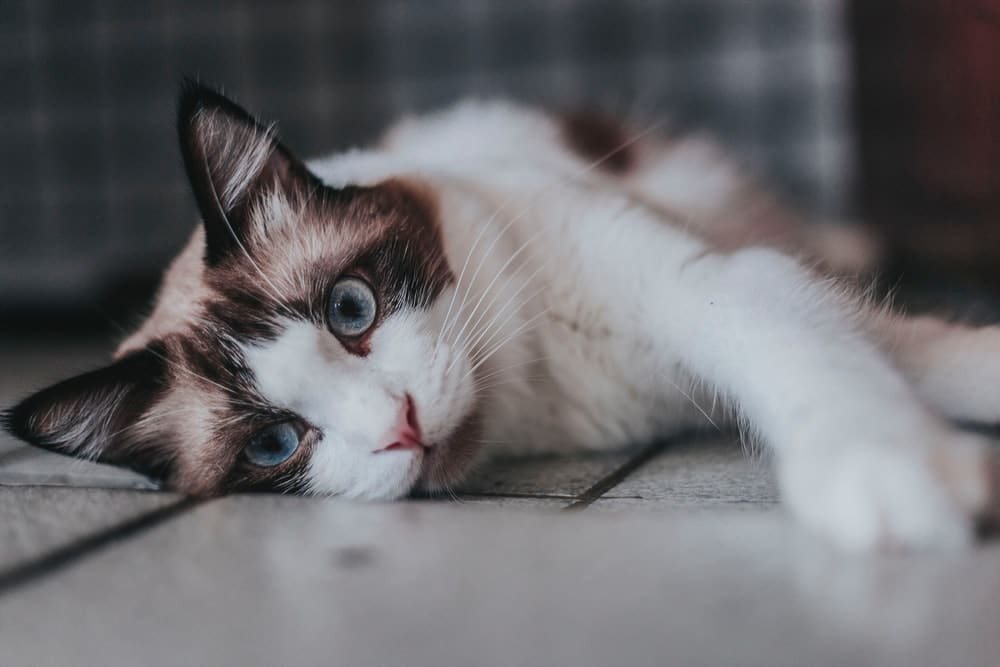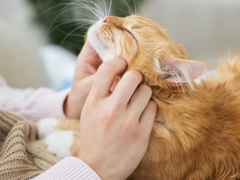
Pyometra in cats, defined as an infection of the uterus, is nothing to play around with. It is life-threatening and requires immediate and aggressive treatment.
Without treatment, cats with pyometra can become extremely ill and possibly lose their lives because of the havoc that pyometra can wreak on the rest of a cat’s body.
There’s a lot to learn about pyometra, so settle in and keep reading.
Causes of Pyometra in Cats
To understand what causes pyometra, we first need to review some basics about a female cat’s reproductive cycle. Like a female human, female cats have a reproductive cycle, during which the levels of various sex hormones, including estrogen and progesterone, fluctuate and affect the reproductive organs.
When a female cat enters the estrus part of her cycle (aka, being in heat), she is ready to mate. For several weeks after estrus, her progesterone levels go up and stay up. Progesterone stimulates the thickening of the uterine lining, called the endometrium, to prepare for pregnancy.
If the cat goes into heat several times but does not get pregnant, her uterine lining keeps getting thicker. The lining becomes so thick that it begins to form cysts, a condition called cystic endometrial hyperplasia.
This cystic uterine lining begins to leak fluid. But, because the lining is so thick, the uterine muscles cannot contract strongly enough to expel the fluid from the uterus. Thus, the fluid essentially becomes a sitting duck for infection.
To make matters worse, white blood cells (WBCs) are absent from the scene. During estrus, WBCs are blocked from the uterus so that sperm can travel safely without being attacked by these immune cells.
As if that wasn’t enough, the cervix, through which sperm travels to get to the uterus, relaxes when a cat is in heat. This relaxation also allows bacteria from the vagina to enter the uterus. Because there are no WBCs, the bacteria enter the uterus and set up shop, leading to pyometra.
Who Gets It?
Pyometra in cats usually affects cats who are at least six years old but can also affect younger cats.
Intact female cats have the highest risk of developing pyometra. However, cats who are spayed (ovaries and uterus removed) can also develop this condition.
How Could That Be?
Infrequently, a spay is incomplete, meaning that a portion of the uterus, called a ‘stump,’ remains attached to the cervix. This uterine stump can thicken when progesterone levels rise, potentially leading to what’s called ‘stump pyometra.’
How Long Can a Cat Live with Open Pyometra?
A cat with open pyometra may survive for several weeks if untreated, but the condition is life-threatening and can lead to severe complications like sepsis. Immediate veterinary care is essential, as surgery is usually required to save the cat’s life.
Symptoms of Pyometra in Cats

Though pyometra is a serious condition, it doesn’t always cause distinct or severe symptoms.
Surprisingly, pyometra doesn’t always cause severe symptoms. Also, some of these symptoms, including lethargy, anorexia, and vomiting, are non-specific. Affected cats might also drink more water and urinate more often, but these symptoms aren’t specific to pyometra either.
Pyometra symptoms are typically classified according to whether the cervix is open or closed.
Early signs of pyometra in cats include a telltale symptom of open pyometra is fluid leakage from the vagina. This fluid might be blood-tinged and can be seen under the tail or in places where a cat frequents (e.g., bed, furniture). Because cats are such fastidious groomers, though, your cat might clean up the leakage before you see it.
Symptoms are more severe with closed pyometra because the fluid is trapped in the uterus. For example, the abdomen will be painfully enlarged. Also, a cat will look visibly and seriously ill because the bacteria in the uterine fluid leaks into the bloodstream and releases toxins. The kidneys, working overtime to filter out those toxins, stop working well. In addition, the uterus might become so swollen with fluid that it bursts, spilling that liquid into the abdominal cavity.
Diagnosis of Pyometra in Cats
Any intact female cat that has a swollen, painful abdomen and is drinking more water than usual has pyometra until proven otherwise. A veterinarian will perform basic laboratory tests to make the diagnosis.
Bloodwork will reveal an elevated WBC count, which indicates an infection. Also, the urine will be less concentrated because of kidney dysfunction. These results, though, do not specifically point to pyometra.
Imaging tests can help confirm the diagnosis. X-rays are helpful with closed pyometra because the enlarged abdomen and uterus will be very apparent. This enlargement isn’t so evident with open pyometra; in this case, ultrasound is the better diagnostic choice.
Treatment of Pyometra in Cats

Any intact female with a swollen, painful abdomen who’d drinking an unusually large amount of water is presumed to have pyometra. Further tests can confirm the diagnosis.
Treatment for pyometra must be quick and aggressive. In nearly all cases, treatment is an immediate spay. Cats that are very ill first need to be stabilized with intravenous fluids and antibiotics before surgery.
Surgery can be difficult because a uterus that is swollen with fluid is fragile and prone to bursting.
After surgery, oral antibiotics are given for several weeks.
Rarely, pyometra is treated medically with prostaglandins. Prostaglandins reduce progesterone levels, which will decrease uterine lining thickening, open the cervix, and allow the uterine fluid to leave the body.
Cost of Pyometra Surgery for Cats
The cost of pyometra surgery in cats in the USA can vary widely depending on several factors, including the location, the severity of the condition, the type of veterinary clinic (emergency clinic vs. regular vet), and whether additional treatments are needed.
On average, the cost of pyometra surgery for cats in the USA can range from $1,000 to $2,500. This cost typically includes the surgery itself, anesthesia, hospitalization, medications, and post-operative care. In some emergency cases or at specialty clinics, the cost could be higher, reaching up to $4,000.
Medical treatment would be for cats who will be bred in the future. However, medical treatment is not always successful, meaning that pyometra can recur. Also, prostaglandins can have serious long-term health consequences.
Prevention
The best way to prevent pyometra in cats is to have female cats spayed when they are young and healthy. Cats can be spayed as young as eight weeks.
Frequently Asked Questions
What if I want to continue breeding my cat?
By far, spaying is the most effective treatment for pyometra. However, medical treatment is an option for female cats who are still being bred. Prostaglandins will lower progesterone levels in the blood, which will reduce uterine lining thickness and help expel uterine fluid from the body. However, prostaglandins don’t always work, leading to possible pyometra recurrence. Plus, they can have serious long-term health effects.
I don’t see any fluid leaking from my cat’s vagina. Do I still need to take her to the vet?
Yes! Your cat could have already cleaned up the discharge, or have closed pyometra. Either way, your cat will need immediate treatment.
Could my cat get pyometra again?
If your cat is spayed after her pyometra diagnosis, and her ovaries and uterus are completely removed, she will not develop pyometra again. If your cat receives medical treatment, her risk for getting pyometra again is much higher.







